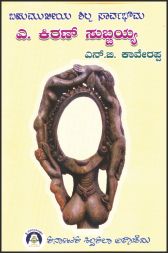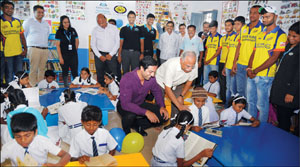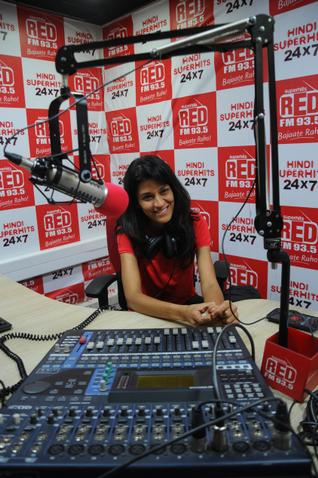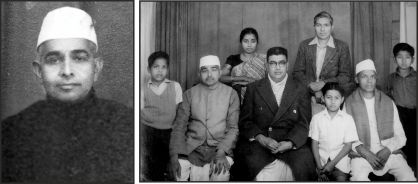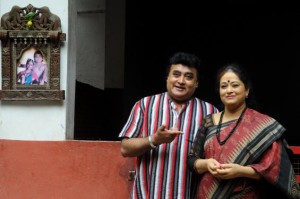
In an age marked by excessive competition, Bharatanatyam duo Kiran Subramanyam and Sandhya Kiran tell Archana Nathan that there can be no substitute for hard work, practise and simplicity
For years now, the sound of the thattu kazhi emerging from a low-roofed house on 18th cross road in Malleswaram in Bangalore, has greeted commuters and passers by. There are tiny boards with the title ‘Rasika Arts Foundation’ pinned onto the gates today but nothing else has changed about the appearance of the 27-year-old dance school set up by Bharatanatyam duo Kiran Subramanyam and Sandhya Kiran. It is modest in size, retains an old-Bangalore charm, and has survived the commercial strains tugging at the heart of Malleswaram.
This, however, is not so surprising when you meet the Kirans. If you walk into the room in which Kiran and Sandhya took their first class in 1989 for a batch of four students — a room that is kept intact and now houses a tiny study — one sees that the foundation of humility and simplicity has been laid by the hosts themselves. Years have come and gone but their simplicity seems to have been untouched.
Kiran and Sandhya are not new to those who are familiar with the landscape of Bharatanatyam in Bengaluru. Their institution has been prolific whether in terms of dance productions, workshops or collaborations. It is home to around 300 students and is the alma-mater for many others settled across the world.
The couple met when they were both students of Padmini Ravi and then went to train under the Dhananjayans in Chennai – V.P. Dhananjayan and Shantha Dhananjayan – before setting up the Rasika Academy finally in 1989. “When Sandhya came to learn from Padmini Ravi, she had already learned Bharatanatyam for a few years. I was one among two male students in the class at that time. I was very confused because while my heart was in dancing, I was wondering whether I could take it up full-time. Sandhya and I became the best of friends and eventually I told her I want to take up dance as my career. She only said one thing: ‘If you have the conviction, then go ahead. Somehow things will fall in place,’a dictum she believes even today,” says Kiran. By then, Sandhya had already ditched options of CET and Engineering to take up an arts course, just so that she could focus on dance.
“I realised there was a certain oneness in our thought process and I felt I should ask Sandhya to marry me. When I did, she said she wanted a day’s time. I don’t know what she did in that one day,” he recalls. “I also don’t know what I did with that day. But I told him the next morning that I was okay with getting married but that I was scared too,” adds Sandhya.
When the couple went to their guru, Padmini Ravi, to tell her that they wanted to take up dance as their career, they got a rather unexpected response. “She said if you are going to take this up as a profession, then I will not allow you into my class. We did not know it then but this was her way of testing us whether we were serious about our decision. Later, she sat down with us and spoke to us about what taking up dance as a career really entails,” recalls Kiran.
Padmini Ravi, say the Kirans, is someone they are in love with. “Not only was she unconventional when it came to the kind of innovations she introduced in classical dance, she was also unorthodox when it came to her relationship with her students,” says Sandhya. “Fearless is the word. She didn’t hesitate in trying different choreographies and movements. She presented her dance in such a beautiful manner that others too were encouraged to try new things. Sometimes, we feel that a part of her fearlessness has rubbed off on us too,” adds Kiran.
How did they choose to go to the Dhananjayans in Chennai? “We wanted to learn the nuances of ‘duet dancing’ from them. But another aspect that we discovered is their proficiency in what we today call art management. Apart from stellar dancing, the Dhananjayans knew how to take care of communication, networking and public relations at a time when all of these weren’t professions in themselves. They could put together a show perfectly all by themselves,” says Kiran. “Shantha akka used to say, V.P. na enna theriyuma? (you know what VP stands for?) ‘Very Punctual’ Dhananjayan,” says Sandhya.
From the Dhananjayans, the Kirans learnt the essence of a duet. “A duet demands that ideas, concepts and thought processes of the two dancers match too. Of course there needs to be synchronisation in terms of physical movements. But most importantly, the sattvam – the essence – has to be one even if it is two different individuals and mindsets performing together,” they explain.
They recall how in the initial days of Rasika, the first half of the month would be spent teaching their students and the second half, travelling to Chennai and performing there. Teaching, they say, helped them look at dance differently. “With a school like Rasika, it became our responsibility to create the next generation of connoisseurs of dance. These need not be dancers but people who can appreciate dance, which is crucial today,” says Sandhya.
Having seen a whole new generational change of students over the years, the Kirans feel that students today are a bit impatient and want to have it all. “It is not just the students but their parents too who get worried if their child is not up on stage in a few months after he or she has started learning dance. That apart, young dancers today want to be everywhere and do everything at the same time. They strain and injure their body in the process. Reality TV and Facebook’s offer of instant popularity has made things worse. There are very few takers for the long haul, for a deep investment in dance,” they say.
Is it also because of a lack of conviction? “There is either a lack of conviction or just too much conviction that they can do everything under the sun. Creativity cannot be forced or planned. It is intuitive,” says Sandhya.
Ultimately, it is a phase, they say. “A Facebook post today about someone’s dance or play performance is now capable of sparking off a whole gamut of insecure reactions in many others. It is quite amusing to be honest. Why can’t one do one thing properly and focus on it? Why is there such a plaguing worry of irrelevance today? What substitute can there be for hard work and simplicity?” they ask.
source: http://www.thehindu.com / The Hindu / Home> Features> Friday Review / Archana Nathan / Bengaluru – July 28th, 2016

